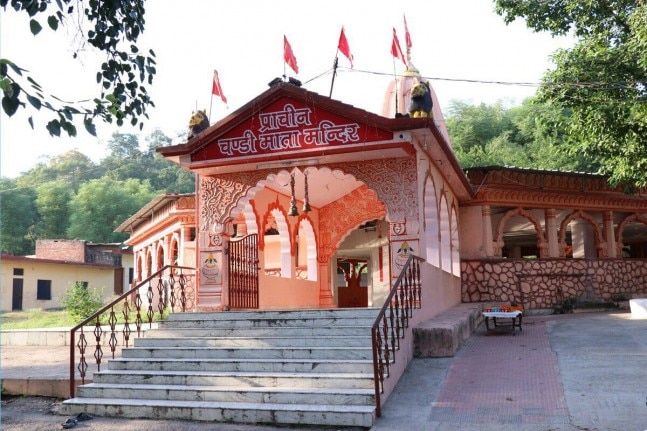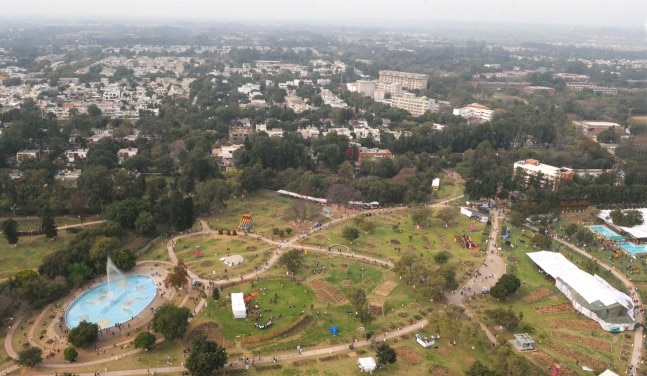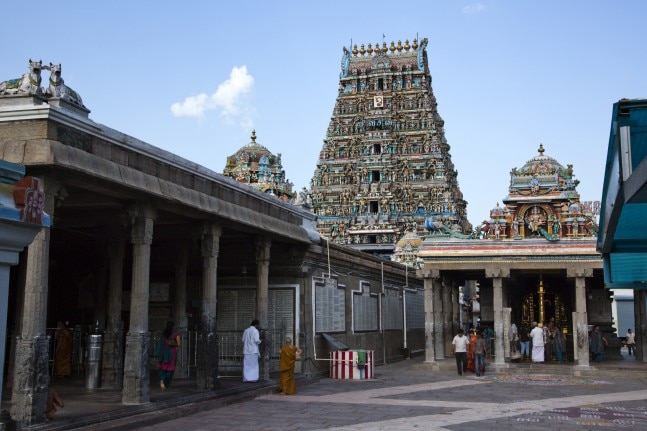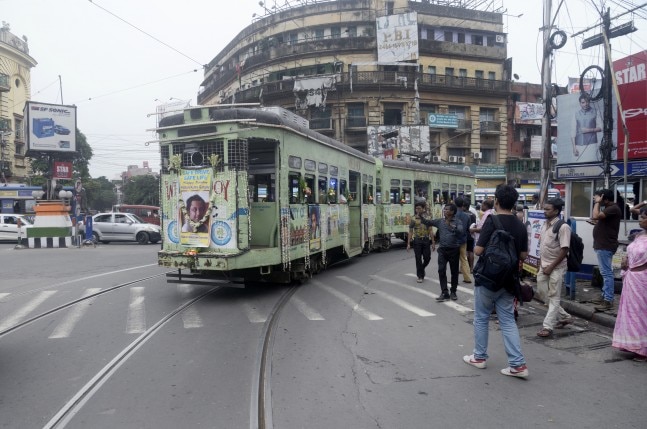Interesting facts about 28 Indian states and 8 Union Territories with their capitals
There are 28 states and Eight Union territories in the country.
Let's take a look at the states and their capitals.

Indian states and their capitals.
(Image: Getty Images)
India, a union of states, is a sovereign, secular, democratic, republic with a parliamentary system of government. The President is the constitutional head of Executive of the Union.
In the states, the Governor, as the representative of the President, is the head of Executive.
The system of government in states closely resembles that of the Union.
There are 28 states and Eight Union Territories in the country.
Union Territories are administered by the President through an administrator appointed by him/her.
Let's take a look at the states and their capitals:
1. Andhra Pradesh - Amravati

Amravati city plan. (Image: Amravati.gov.in)
- Hyderabad was the former capital of Andhra Pradesh but it got replaced by Amravati, people's capital. The foundation stone was laid on October 22, 2015.
- The Buddhist Stupa at Amravati is the biggest stupa in the country with a diameter of 50 meters and a height of 27 meters
- Recognising Amravati's ancient Buddhist roots, the developers also plan to a design the High Court in a way that it resembles the Buddhist Stupa
- According to the timeline of this mega project, Andhra's capital will be populated and functional only by 2024, i.e after the end of its second phase, when most of the buildings, commercial establishments, universities, and the central business district will become operational. The third and final phase is expected to be completed by 2029.
2. Arunachal Pradesh - Itanagar

Gompa at Itanagar, Arunachal Pradesh, India. (Image: Getty Images)
- Itanagar has been the capital of Arunachal Pradesh since April 20, 1974
- Arunachal Pradesh is India's largest state in the Northeast.
advertisement
3. Assam - Dispur

Distant view of Brahmaputra river at Assam, India. (Getty Images)
- Initially, Shillong was the capital of Assam but got replaced by Dispur in 1972
- Dispur is a locality or suburb in Guwahati city that is why Guwahati is often referred to as the capital city of Assam.
4. Bihar - Patna

Patna Museum in Bihar, India. (Image: Getty Images)
- Patna is the largest city of the state of Bihar, 19th most populous city and the fifth fastest growing city in the country
- Being a place of several strip rivers, including Sone, Gandak, and Punpun, Patna is known as the largest riverine city in the world
- In 1912, Patna became the capital of the British province of Orissa and Bihar till 1935 when Orissa became a separate state
- Most notable Satyagraha movements of Mahatma Gandhi namely the Champaran movement against the Indigo plantation and the 1942 Quit India Movement were started from this city.
5. Chhattisgarh - Atal Nagar (Naya Raipur)

Swagat Vatika at the Naya Raipur entrance. (Image: Naya Raipur Development Authority)
- Chhattisgarh's new capital Naya Raipur will be renamed as Atal Nagar in memory of former Prime Minister Atal Bihari Vajpayee
- The announcement was made by Chhattisgarh's chief minister, Raman Singh, on August 21, 2018
- Raipur was the former capital of Chhattisgarh. The town of Raipur has been in existence since the 9th century.
6. Goa - Panaji

Fontainhas is the old Portuguese quarter of Panaji. (Image: Getty Images)
- Panaji is also known as Panjim in English, Ponnji in Konkani, and Pongim in Portuguese
- After Independence, Indian Army attacked Goa including Panaji and uprooted the Portuguese controls in 1961. Thereafter, Goa was merged with India as a Union Territory
- It was declared as a state of India in 1987 along with Panaji as the capital of Goa
7. Gujarat - Gandhinagar

Aerial view of Maha aarti being held in Gandhinagar, Gujarat, India. (Image: gandhinagarportal.com)
- In 1960, the Indian state of Bombay was split into two states, Maharashtra and Gujarat. The city of Mumbai was given to Maharashtra, leaving Gujarat without a capital city
- At that time, Ahmedabad was selected to be the first capital of the newly created state
- It was later proposed that a new capital city should be constructed for the state along the lines of the other two planned cities of India, Chandigarh, and Bhubaneshwar
- Gandhinagar got its name from the Father of the Nation.
8. Haryana - Chandigarh

Chandi Mata temple in Chandigarh, India. (Image: chandimatatemple.com)
- Chandigarh derives its name from the temple of 'Chandi Mandir' located in the vicinity of the site selected for the city. The deity 'Chandi', the goddess of power and a fort of 'garh' lying beyond the temple gave the city its name 'stronghold of the goddess Chandi
- With the partition of India in 1947, the old British province of Punjab was divided into two parts. The larger western part, including the Punjabi capital of Lahore, became a part of Pakistan
- The eastern part was granted to India, but it was without an administrative, commercial, or cultural centre
- Plans to find a suitable site for the capital of the new Indian Punjab were undertaken soon after the partition
- The Indian government after considering several options selected Chandigarh as the capital in 1948.
9. Himachal Pradesh - Shimla/Dharamshala

An
overview of the stadium during the 2010 DLF Indian Premier League T20
match at Himachal Pradesh Cricket Association Stadium, Dharamsala, India
(Image: Getty Images)
- Jammu and Kashmir is not the only state with two capitals anymore. In 2017, Dharamsala was declared as HP's winter capital, which means it'll have two capital cities i.e. Shimla and Dharamshala
- Dharamshala is also the hometown of Tibetan spiritual leader Dalai Lama.
10. Jharkhand - Ranchi

People enjoying at the Rock Garden, Ranchi, where there is a replica of the pyramid of Giza. (Image: Getty Images)
- Jharkhand is one of the richest mineral zones in the world and boasts of 40 per cent and 29 per cent of India's mineral and coal reserves respectively
- Jharkhand is the only state in India to produce coking coal, uranium and pyrite.
11. Karnataka - Bengaluru

Infosys Campus, Bangalore, India. (Image: Getty Images)
- Bangalore, officially known as Bengaluru, is the capital of south Indian state, Karnataka. After India's independence in 1947, Bengaluru became the capital of Mysore State and remained its capital till the new Indian state of Karnataka was formed in 1956
- Bengaluru is also known as the 'Silicon Valley of India' because of its role as the nation's leading information technology (IT) exporter
- Indian technological organizations, such as ISRO, Infosys and Wipro are headquartered in the city.
12. Kerala - Thiruvananthapuram

Napier Museum, Art and natural history museum, at Thiruvananthapuram, Kerala. India. (Images: Getty Images)
- Thiruvananthapuram, formerly known as Trivandrum, is the capital of Kerala state
- This clean city is built on seven hills, called as Thiru-Anantha-Puram, meaning 'the town of Lord Anantha'.
13. Madhya Pradesh - Bhopal

Chhath festival at Upper Lake, Bhopal, India. (Image: Getty Images)
- Bhopal was founded by King Bhoja in the 11th century. The city was thus named 'Bhoj-pal' and later came to be known as Bhopal
- Bhopal is also known as the 'city of lakes' for its various natural as well as artificial lakes. Bhopal lake, known as the upper lake is the oldest man-made lake in India.
14. Maharashtra - Mumbai
advertisement

Marine Drive aka the Queen's Necklace, in Mumbai, India. (Images: Getty Images)
- Mumbai was formerly known as Bombay till 1995. Mumbai is the financial, commercial and entertainment capital of India
- It is also one of the world's top ten centres of commerce in terms of global financial flow, generating 6.16 per cent of India's GDP.
15. Manipur - Imphal

Mothers Market, Imphal, India. (Image: Getty Images)
- Ima Keithal market in Imphal is probably the world's only all-women run marketplace. In Manipuri, Ima means mother and Keithal means market, so it is known as 'Mothers market'
- Only married women are allowed to trade and run the stalls in this multi-ethnic 500-year-old marketplace, a privilege that is passed on from one generation of Manipuri women to the another.
16. Meghalaya - Shillong

General view of the hills, the caves, the waterfalls, the streams of Shillong, India. (Image: Getty Images)
- Shillong, the capital of Meghalaya, is the only hill station that is accessible from all sides. In 1874, it became the capital of composite Assam under British rule
- In 1972, after the formation of Meghalaya as an independent state, Shillong became its capital
17. Mizoram - Aizawl

Artist
from Mizoram state performs a bamboo dance on the second day of the
state annual Hornbill Festival in Kohima. (Image: Getty Images)
- Aizawl is the political and cultural centre of Mizoram. It is here that the State Legislature is situated
- It is also the commercial hub of the state and all commercial and economic activities are centered around the city.
18. Nagaland - Kohima

A Jhum cultivation field is seen amidst green forest at Tseminyu, India northeastern state of Nagaland. (Image: Getty Images)
- Kohima is the land of the Angami Naga tribe
- The name, Kohima, was officially given by the British as they could not pronounce the Angami name Kewhima or Kewhira, which comes from the Kewhi flowers, which are found all around in the mountains
- Earlier, Kohima was also known as Thigoma.
19. Odisha (Orissa) - Bhubaneswar

Pinnacles decorating Rajarani Temple, Bhubaneswar, India. (Image: Getty Images)
- In 1948, Bhubaneswar replaced Cuttack as the capital of Odisha
- It is also popularly known as the 'temple city of India'.
20. Punjab - Chandigarh

An aerial view of Zakir Hussain Rose Garden during the Rose Festival in Chandigarh, India. (Image: Getty Images)
- Chandigarh as a Union Territory was constituted on November 1, 1966, when the Indian Punjab was reorganised along linguistic lines into two new states- Haryana and Punjab
- Straddled between Haryana and Punjab, the city of Chandigarh was made the shared capital of the two states and of the Union Territory itself.
21. Rajasthan - Jaipur

Amer Fort, Jaipur, Rajasthan. (Image: Getty Images)
- Jaipur is popularly known as the 'Pink city of Rajasthan,' because of its pink coloured buildings
- It was built in the 18th century by Raja Sawai Jai Singh II and was the first planned city of India.
22. Sikkim - Gangtok

Tsomgo Lake, Gangtok, Sikkim, India. (Image: Getty Images)
- The name Gangtok is derived from a Tibetan word, which means 'hilltop' or 'top of the hill'
- With the presence of several monasteries, centres for tibetology and religious educational institutions, Gangtok is a famous centre of Tibetan Buddhist culture.
23. Tamil Nadu - Chennai

Kapaleeshwarar Temple, Chennai, Tamil Nadu, India. (Image: Getty Images)
- Chennai, formerly known as Madras Patnam, is 380 years old. From a stretch of no man's land in 1639, it has grown to become a major industrial, business and cultural centre
- Chennai Corporation initially called as Madras municipal corporation is the oldest Municipal Corporation in India established in 1688.
24. Telangana - Hyderabad

Hyderabad's most popular monument, Charminar, was built in 1591 AD. (Image: Getty Images)
- Telangana was constituted as the 29th state of India on June 2, 2014
- Hyderabad was the joint capital of Telangana and Andhra Pradesh until 2015
- Now, Hyderabad is only the capital of Telangana.
25. Tripura - Agartala

The
Goddess in the hills of Unokoti seen carved in the rock hosts an
ancient Shaivite place of worship with huge rock reliefs celebrating
Shiva. (Image: Getty Images)
- Agartala is a component of two words -- namely Agar, a kind of oily valuable perfume tree and tala, a storehouse
- The percentage of literacy in Agartala, according to 2011 census, was 93.88, higher than the national literacy rate.
26. Uttar Pradesh - Lucknow

Bara Imambara, Lucknow, India. (Image: Getty Images)
- Lucknow is popularly known as 'The City of Nawabs'. It is also known as the Golden City of the East, Shiraz-i-Hind and the Constantinople of India
- Lucknow was the epicenter of the 1857 War of Independence.
27. Uttarakhand - Dehradun

Prince
Charles, Prince of Wales and Camilla, Duchess of Cornwall visit the
Indian Military Academy in Dehradun, India.(Image: Getty Images)
- Dehradun is mentioned in the Ramayana and Mahabharata in the ancient puranic stories making it one of the oldest cities of India
- Dehradun is also called as the Abode of Guru Drona
- The Central Braille Press in Dehradun is the largest producer of Braille textbooks in India.
28. West Bengal - Kolkata

A
tram, decorated with pictures of the legendary singer and actor Kishore
Kumar moving through various parts of the city in Kolkata, India.
(Image: Getty Images)
- Until 1911, Kolkata was the capital of India due to its trade importance during the British Rule in India. Later, Delhi was made the capital of India
- In 2001 the city's name was officially changed from Calcutta to Kolkata. A legacy of the Raj, Kolkata is one of the fewest cities in the world to have retained the tradition of Tram
- Though these are slowly rumbling into history, but Trams continue to fascinate many, including travelers from other cities
- Birla Planetarium in Kolkata is the largest planetarium in Asia and second largest in the world. Kolkata is the only city to have hand-pulled rickshaws in India
Now let's take a look at Union Territories and their capitals
1. Andaman and Nicobar Islands - Port Blair

The scenery of Andaman and Nicobar islands on the note.
- The largest sea turtles in the world, Dermocheleys Coriacea, nest in the Andaman and Nicobar Islands
- The scenery on our red coloured 20 rupee note depicts a natural scene on the Andaman and Nicobar islands
- The only active volcano in India is present in Andaman
2. Chandigarh - Chandigarh
3. Dadra and Nagar Haveli - Silvassa
- Dadra and Nagar Haveli lies near the west coast and consists of two separate parts. Dadra is surrounded by the state of Gujarat, and Nagar Haveli lies on the borders of Maharashtra and Gujarat
- It was a Portuguese colony till 1779 and became a part of Independent India in 1954
- Till 1961, it was self-governing and operated independently. then, in the same year i.e. 1961, it became a union territory of India
- Currently, Dadra and Nagar Haveli has representation in both houses of the Indian parliament
- Dudhni lake in Silvassa is famously referred to as 'Kashmir of the West'
4. Daman and Diu - Daman
- Goa, Daman, and Diu were incorporated into the Republic of India on December 19, 1961, by military conquest
- The territory of Goa, 'Daman, and Diu' was administered as a single union territory until 1987, when Goa was granted statehood, leaving Daman and Diu as a separate union territory.
5. Lakshadweep - Kavaratti
- Kavaratti Island is the base for INS Deeprakashak, a crucial Indian Navy Base
- Kavaratti has been an important Indian Navy Base since the 1980's. However, INS Deeprakashak was commissioned in the year 2012.
6. Delhi (National Capital Territory) - Delhi
- New Delhi is both the capital and center of the government of India as well as the center of the National Capital Territory of Delhi
- In 1991 the Constitution Act changed the Union Territory of Delhi to the National Capital Territory of Delhi.
7. Puducherry (Pondicherry) - Pondicherry
- Earlier the name of this territory was Pondicherry. It was changed to Puducherry on September 20, 2006
- Puducherry is better known as the 'White town'
- Puducherry celebrates Independence Day on August 16, while the rest of the nation celebrates it on August 15
- The former capital to Puducherry was Madras.
8. Jammu and Kashmir - Srinagar/Jammu

Tourists enjoy shikara ride on the waters of Dal Lake in Srinagar, India. (Image: Getty Images)
- Jammu and Kashmir was the only state having two capital cities until 2017. In Jammu and Kashmir, every year there is a shift of the secretariat and all other government offices from Srinagar to Jammu and vice versa
- This bi-annual shift is known as Darbar move. From May to October, all the government offices are housed in Srinagar which is the summer capital of the state and from November to April, the offices are housed in Jammu which is the winter capital of the state
- The Jammu and Kashmir High Court also move from Srinagar to Jammu in winters and from Jammu to Srinagar in summers.
To get more updates on Current Affairs, send in your query by mail to ajaykbhagat99@gmail.com
STAY UPDATED WITH US AJAY K. BHAGAT
ajaykbhagat26.online
Tags
Current Affairs